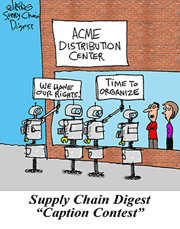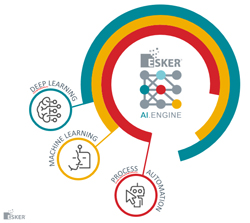Will there Really be Good US Manufacturing Jobs Again?
One of the most important and frankly interesting issues in supply chain in recent years has been the possibility of a resurgence of US manufacturing.
That prospect had started gain some currency before Donald Trump was elected president under promises of making US manufacturing great again - SCDigest and MIT's David Simchi-Levi conducted a major survey back in 2012 looking at the prospects for what had recently been called "reshoring."
That of course referred to bringing manufacturing back largely from China and other low cost Asian countries after so much production had moved offshore in the first decade of the 2000s.
| GILMORE SAYS: |
I think the Wabec Erie plant will be another in what has been a series of important inflection points in labor's position in the USA in recent years.
WHAT DO YOU SAY?
Send us your
Feedback here
|
The survey in 2012 found a lot of interest in reshoring, but not much action yet. And while there have been a number of companies that have indicated that they have or may bring some production back from China due to the new tariffs on hundreds of billions of Chinese imports, here is the reality: the US trade deficit in goods with China easily set a new record in 2018, at an incredible $419 billion, up hugely from a mere $375 billion in 2017.
Meanwhile, another reality is that US manufacturing output, as measured by the monthly Federal Reserve index, is still below peak 2007 levels, and is up less than 1% annually versus the current baseline year of 2012. (Another measure, tracking US manufacturing "value add," is more positive, showing the US at last surpassing 2007 levels in 2018.)
I offer those thoughts and data in the context of two news items that caught my eye in recent weeks.
First involved the closing of the GM plant in Lordstown, OH, near Youngstown. Some 1500 workers lost their jobs, but that was down from the more than 5000 the factory employed at its peak. The plant been the scene of several widely publicized labor related issues since it first opened in 1966. More recently, it kept itself open by agreeing to some wage concessions - largely involving a so-called "two-tier" system, where new workers start at a much low wage than current autoworkers make.
But in the end, that wasn't enough, as demand for the smaller sedan type cars made in Lordstown continues to fall, and the automakers say they simply can't possibly make smaller cars in the US.
My mother grew up in the Youngstown area. It's where my grandparents lived until their death. The region was beyond decimated by the closer of steel mills in the 1970s, in which literally tens of thousands of jobs were lost almost overnight. The city is a sad shell of its former self.
Now the Lordstown plant is gone too.
So let's move not all that far away to the Erie, Pennsylvania area. As we reported earlier this week, the sale of GE's locomotive business to a company called Wabtec caused almost instant labor conflict.
Within a couple of days of the acquisition, Wabtec demanded significant concessions from the workers at an Erie factory, where most workers are represented by the United Electrical, Radio and Machine Workers of America and make locomotives.
Management said it is willing to keep the existing workers at the current average of about $35 per hour - not a bad living.
But in return, as with GM and other automakers and many other US manufacturers, Wabtec wants to create a second pay tier for new workers and even current workers if they come back from a layoff, with wages of $16.75 to $25 per hour. I say not too bad at the top of that range, not so good at the bottom.
The union went on a brief strike over the issue, before a deal was struck to keep working under the current contract through June 6. Talks are proceeding as the 1700 workers are back on the job for now.
This is happening in interesting times, when there are certainly movements afoot that say corporations are getting too great a share of the rewards, CEO pay is out of control, etc. It will be a key issue in the 2020 election.
As an example of that line of thought, Moshe Zvi Marvit and Andrew Stettner, both fellows at the Century Foundation, recently wrote an opinion piece in the New York Times that said "The fight between the Erie workers and Wabtec shows that despite our collective popular imagination about American manufacturing jobs, the current reality and the future of a promise of good-paying work are quite different."
That column notes that upon the completion of the Wabtec acquisition of the GE business, the company's CEO received a bonus of about $16 million - then promptly asked for the wage concessions.
That, it seems to me, is indeed rather unseemly.
In line with the some of the recent thinking by Democratic politicians, Marvit and Stettner argue that "Workers are now in a position to demand a greater share of a company's success."
Are they? Wabtec has stated that its wage proposals in Erie are in line with its other plants and necessary to compete with "low cost" plants in China and Mexico.
All this in time of what might even be called an acute shortage of manufacturing workers, in the hundreds of thousands by most counts currently, and expected to rise to millions of unfilled openings over the next ten years.
But as with shortages of truck drivers and distribution center workers, employers have largely avoided the logical step of raising wages to attract new workers. For a long period, manufacturing wages were rising on average just 1.4% per year - less than inflation, so workers were falling even further behind.
That may be changing at last. In February, the Federal Reserve Bank of Atlanta said its wage growth tracker showed a 12-month running average of wage gains in manufacturing of 3.9% - the highest such level since May 2008.
I hope we can all agree that is a good thing.
I think the Wabec Erie plant will be another in what has been a series of important inflection points in labor's position in the USA in recent years. Most of those have recent touch points have gone against labor, such as workers turning down unionization at foreign automakers at Tennessee and Mississippi factories, an organizing effort at Boeing in South Carolina also failing, and a 2012 strike at a Caterpillar plant in Joliet, IL that some called "labor's last stand," which ended with a contract largely in Cat's favor.
In the end, Wabtec will probably largely get its way with the Erie workers too. The plant probably is uncompetitive with Mexican factories. Likely there are foolish work rules that hamper productivity and flexibility, which were a big source of US automaker woes in the 1990s.
And the threats of robotics is increasingly there as an alternative to expensive human workers. So it may be better to concede than lose the jobs altogether, though even that approach couldn't save Lordstown.
It just seems unlikely, except in heavily automated, new age factories with a small number of workers, that manufacturing jobs will even again be a real conduit to the middle class.
I understand the economics and the market dynamics, and have been accused of being anti-union in the past with some justification, but Lordstown and Erie have led me to ponder our manufacturing future yet again?
Any reaction to Gilmore's thoughts on US manufacturing jobs? Let us know your thought at the Feedback section below.
|



![]()

![]()

![]()












